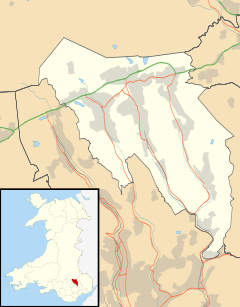- Cwm, Blaenau Gwent
-
Coordinates: 51°44′27″N 3°10′52″W / 51.7409°N 3.1812°W
Cwm, Blaenau Gwent Welsh: Y Cwm
 Cwm, Blaenau Gwent shown within Blaenau Gwent
Cwm, Blaenau Gwent shown within Blaenau GwentPopulation 2,855 OS grid reference SO1805 Principal area Blaenau Gwent Ceremonial county Gwent Country Wales Sovereign state United Kingdom Post town Ebbw Vale Postcode district NP23 Dialling code 01495 Police Gwent Fire South Wales Ambulance Welsh EU Parliament Wales UK Parliament Blaenau Gwent Welsh Assembly Blaenau Gwent List of places: UK • Wales • Blaenau Gwent Cwm (from Welsh: Y Cwm meaning "(the) valley") is a former coal mining village three miles south of Ebbw Vale in the county borough of Blaenau Gwent, Wales, within the historic boundaries of Monmouthshire, United Kingdom.
Contents
Etymology
The name Cwm is thought to have derived from the farm on the present day nature reserve (Silent Valley), Cwm Merddog. Cwm is the Welsh word for valley and the name Merddog is believed to be a corruption of the name of the old farm that used to be here, Troed y Rhiw y Myrdd Fach, which translated means 'the foot of the myriad little hills'. But with the development of the village and coal industry the name was just simply shortened to Cwm. Locally the village to its inhabitants and neighbouring areas is sometimes referred to as The Cwm.
History
Originally a rather insignificant spot in the Ebbw Valley, with only a few scattered farms and a water mill until the end of the nineteenth century with the sinking of the Marine Colliery in 1889. Cwm developed as a village at the turn of the twentieth century, with the building of numerous churches, chapels, public houses, working man's clubs, a miners' institute etc, and terraced housing typical of the South Wales Valleys, being constructed in a very straight, linear pattern to house the community that worked in the local collieries.
Coal Industry
The main employment of the village was the coal industry as there were several small collieries and drift mines located on the mountain side as well as the main colliery located on the valley floor.
Marine Colliery
The sinking of this colliery began in 1889 by the Ebbw Vale Steel, Iron and Coal Company Ltd. The downcast shaft being 418 yards (382 m) deep and the up-cast 414 yards (379 m) yards. The first coal was produced in 1893.
From the Inspector of Mines list 1896, there were 833 men employed producing from the Old coal, Three quarters, Big and Elled seams. In 1913 there were 2,407 men employed. From a report of 1923, there were 944 men working at Marine No. 1, producing from the Old Coal seam and there were 1,097 employed at No. 2 working the Elled, Big Vein and Three Quarters seams.
On 1 March 1927 an underground gas and coal dust explosion killed 52 men. The death toll would have been many more if it hadn't been for the quick thinking of the manager Mr. Edward Gay, who on his arrival at the mine, ordered the ventilation fan to be slowed down so that it wouldn't fan the flames of any fires burning below. It turn out that his actions saved the lives of the men still alive in the district where the explosion occurred. At this time there were 1400 men employed at the colliery but fortunately when the explosion occurred only the night shift were working underground.
By 1935 the ownership of the colliery change hands to Partridge, Jones & John Paton Ltd. who worked the colliery until Nationalisation in 1947, when there were 1,540 men employed.
During the 1970s it became integrated with Six Bells Colliery with all the coal being handled at the Marine. In 1982 £2.5 million was spent on a new skip winding system, also a new coal handling plant was installed on the surface. Marine was the last deep mine to work in the Ebbw valleys, it closed in March 1989.
Transport
The village and the colliery were connected to the GWR rail network with a station in the middle of Cwm and a halt at Marine Colliery to transport the coal it produced. However the station was closed to passengers in 1962 and Marine halt shut when the colliery was demolished in 1989. With the reinstatement of passenger trains on the Ebbw Valley Railway in 2008, there are plans to rebuild Cwm railway station but there has been no commitment or timescale given to a satation in Cwm and it remains a future aspiration.
In 2002 work began on the much needed and overdue Cwm bypass, that have seriously reduced traffic travelling through the village thus easing the congestion and pollution they created.
There are also regurly bus services to Ebbw Vale, Abertillery, and Newport.
Education
Cwm originally had a secondary school called Dyffryn located at the bottom of the village. Dyffryn's catchment area included Waunlwyd and Swffryd. However due to falling pupil numbers Dyffryn Secondary Modern School closed and now all pupils from Cwm go to Ebbw Comprehensive School. Cwm's original primary school was located by the parish hall called Cwmyrderch, but this has also been closed and now the village primary school is located at the top of the settlement by the football field, simply named Cwm Primary School.
Notable people
- Victor Spinetti, actor,[1] born and raised above the fish shop.[2]
- Mark Williams, snooker player, practiced in Cwm Miners' Institute.
References
- ^ Bevan, Nathan (5 April 2009). "Victor Spinetti tells how he saved Ringo Starr from drowning". Wales on Sunday. http://www.walesonline.co.uk/news/wales-news/2009/04/05/victor-spinetti-tells-how-he-saved-ringo-starr-from-drowning-91466-23314035/.
- ^ Massingberd, Hugh (12 November 2006). "My pages were pinned to poor Irene's mound of Venus". The Daily Telegraph. http://www.telegraph.co.uk/culture/books/3656515/My-pages-were-pinned-to-poor-Irenes-mound-of-Venus.html.
External links
Categories:- Villages in Blaenau Gwent
Wikimedia Foundation. 2010.

